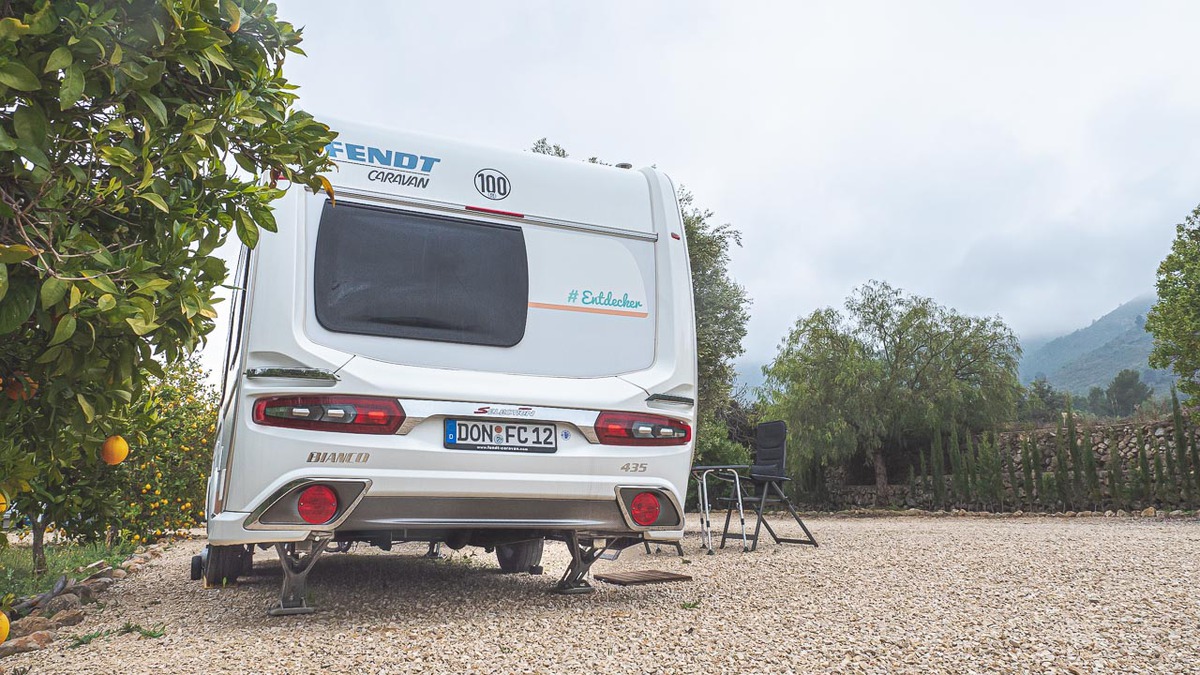How do I align my caravan? Can I use the supports for leveling? And how do I jack up my caravan when it is parked for long periods? Three of the most frequently asked questions (not only) among new caravan owners – and a topic where dangerous half-knowledge is circulating. On level ground, you generally only need to make sure you have a stable footing. However, if the terrain is already slightly uneven, you will need to level it. We explain how to do it properly and what you should never do.
Inhaltsverzeichnis
- Basic knowledge: Overview of the various caravan support systems
- Supporting and aligning the caravan – dos and don’ts
- Use drive-on wedges
- To apply the handbrake or not?
- Supporting the caravan during winter storage and longer periods of inactivity
- Wheel change: jack or caravan supports?
- Tips for listening: Supporting and aligning caravans in the podcast
- Conclusion
Basic knowledge: Overview of the various caravan support systems
Mechanical supports
As standard, caravans are generally equipped with four mechanical supports, also known as plug-in supports, which are located at the corners of the caravan and are cranked up and down by hand. This is why they are often referred to as crank supports. These support systems are available in different versions and load ratings for all caravan chassis and can usually be easily replaced or retrofitted.
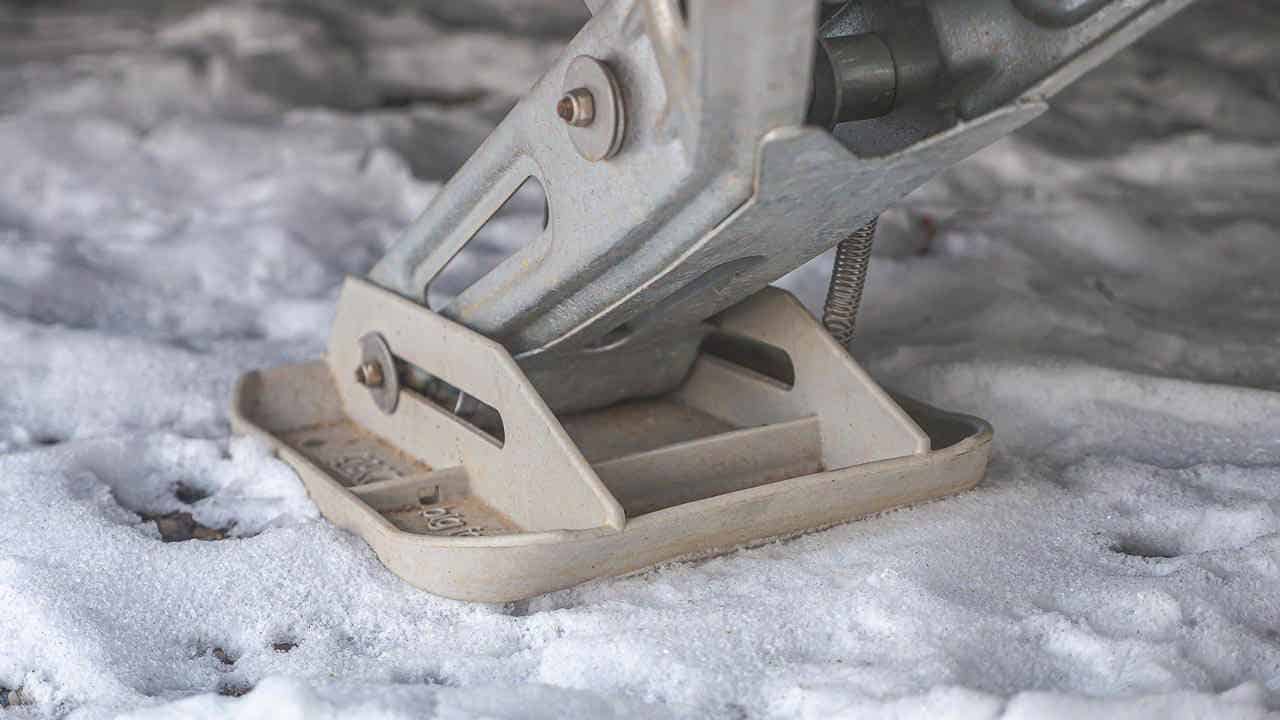
To extend and retract the caravan supports, you use a crank, which is similar to an awning crank and is used in exactly the same way.
Sometimes you may also see campers working on the supports with a cordless screwdriver. This “alternative for the lazy” (which we also use, by the way) seems very charming at first glance, but it does have its dangers: If you use the cordless screwdriver at too high a power, for example, this can lead to damage to the thread, the screw holder or even the body. Chassis and support manufacturers such as AL-KO therefore advise against this technology.
Thimo Boehm, customer advisor in customer service at AL-KO Fahrzeugtechnikwarns: “We often see serious damage such as bending on the supports or even on the chassis that has clearly been caused by the cordless screwdriver. This is not only annoying, but can also be very expensive, as it can invalidate the warranty or guarantee. Especially in the case of chassis damage, a repair like this is really expensive.”
So think carefully about whether you would prefer to do a bit of fitness training and crank the supports by hand. However, if you want to consciously accept the “cordless screwdriver risk”, you should make sure that you set the torque as low as possible so that the cordless screwdriver stops immediately if the supports come into contact with the ground.
Electric supports
The whole thing is much more convenient with support systems with an electric motor. Here, the supports extend at the touch of a button, so you no longer have to crawl around on the floor and flex your arm muscles.
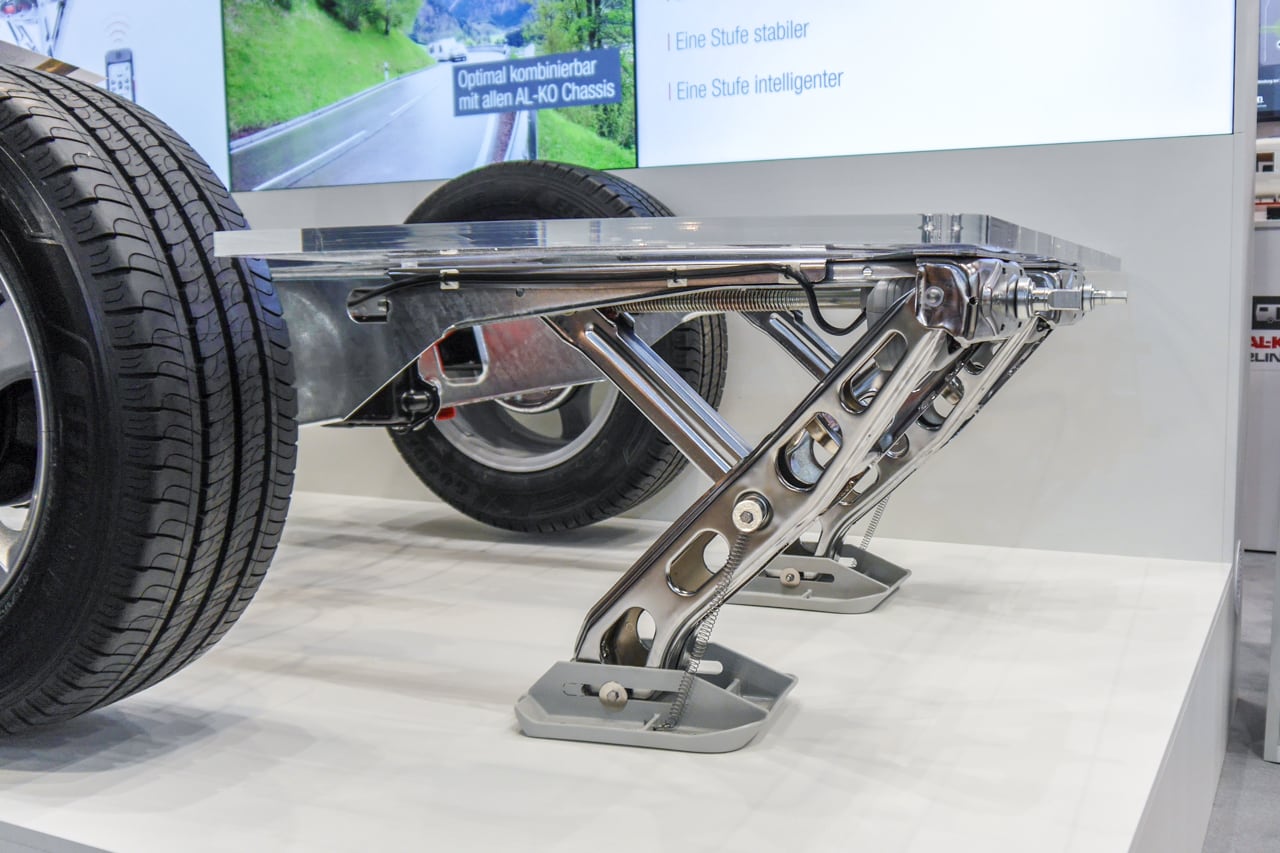
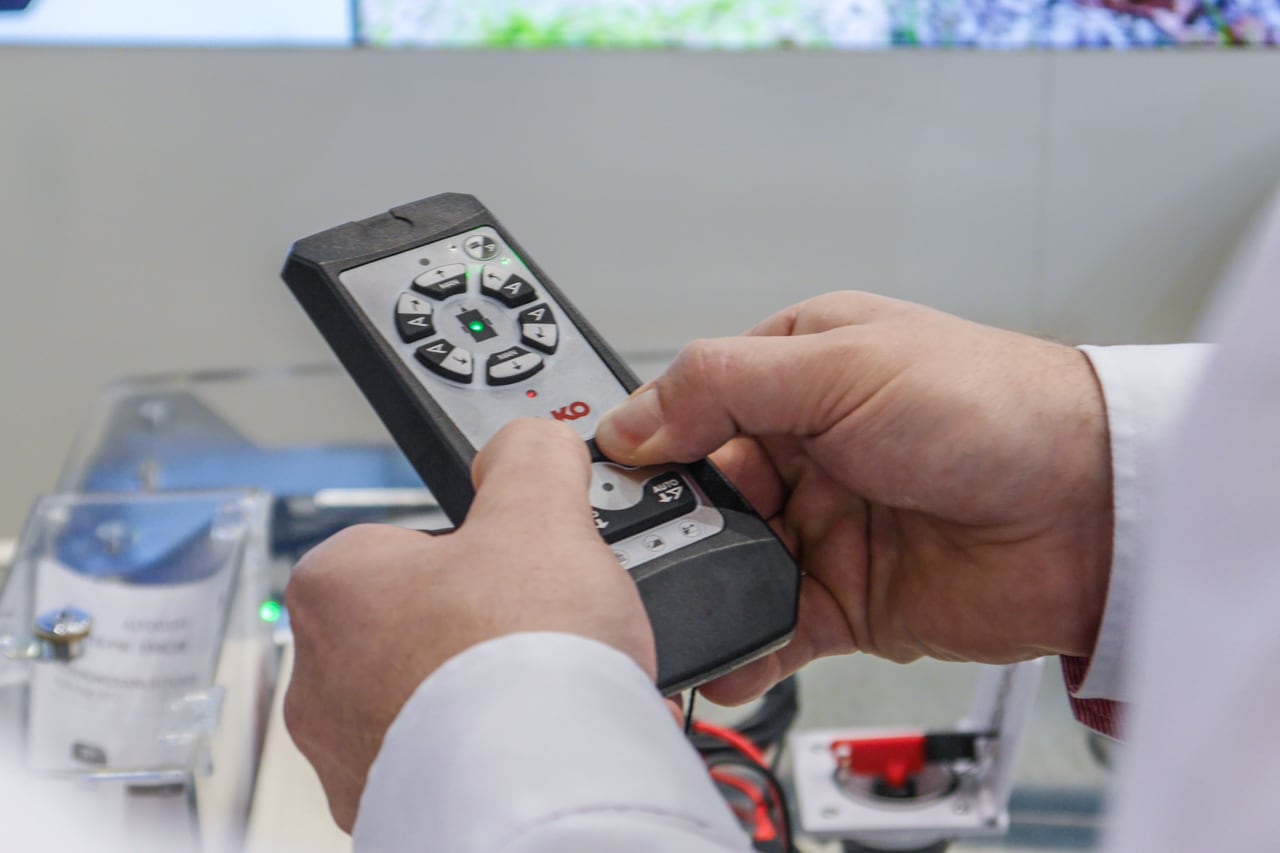
Lifting supports are an invaluable advantage for people with limited mobility or back problems, as well as for campers who frequently change location. Another advantage of this variant: if your caravan has electric supports, you can park closer to hedges or other plot boundaries, as you no longer have to allow space for cranking.
Info
Further information:
Electric support system from AL-KO for caravans
Hydraulic supports
The premier class: the hydraulic support system. Unlike motorhomes, this technology is still relatively new for caravans. Hydraulic props consist of two main props on the axle and four props at the corners, which are controlled by a control panel, wireless touchscreen or smartphone.
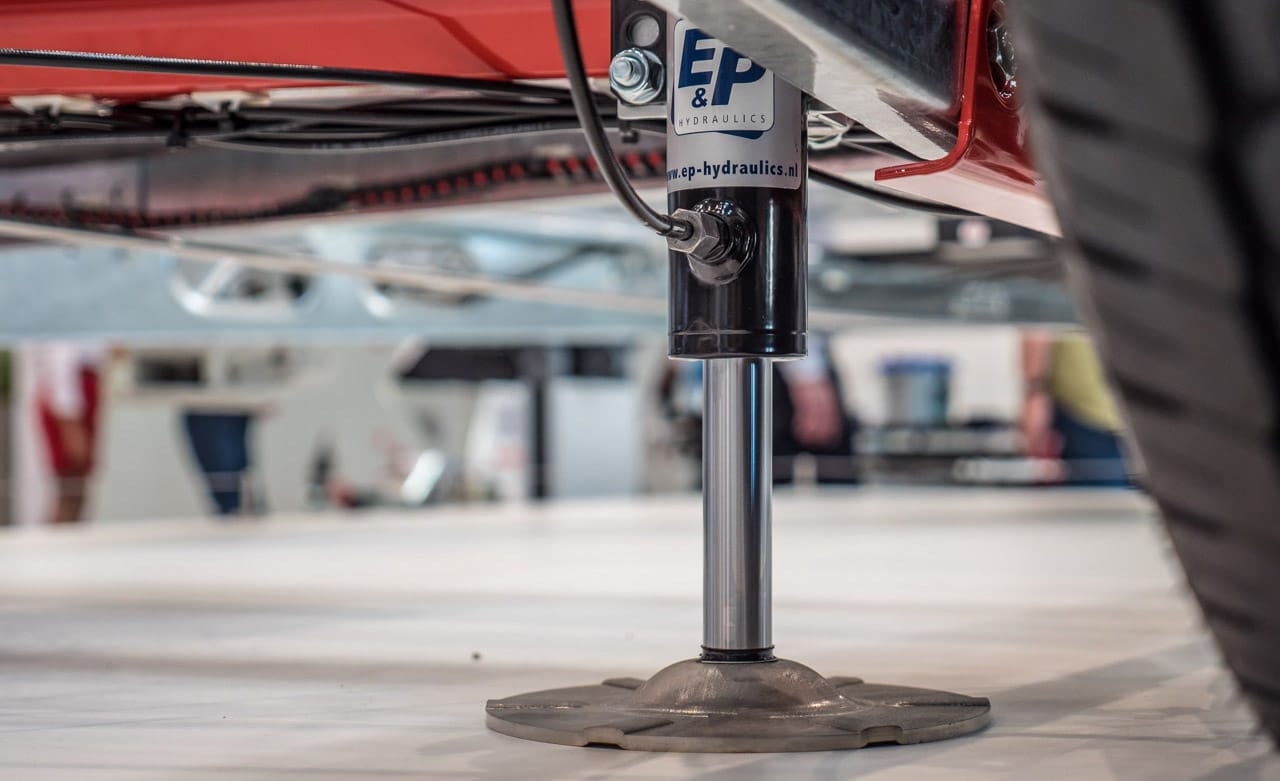
The fascinating thing about this model, which is admittedly not exactly cheap, is that the caravan aligns itself fully automatically. Manual readjustment is generally no longer necessary. In contrast to crank props or electric props, leveling with this new system does not cause any damage to the floor or superstructure. It is therefore the only thing that can be used officially and with a clear conscience for alignment.
Info
Further information:
levelC: Hydraulic support and leveling system for caravans
Supporting and aligning the caravan – dos and don’ts
Once you have arrived at the campsite, the caravan has to be parked, aligned and supported. This is where the most common mistakes are made, because many campers still think that the supports can also be used to level the caravan. This is not the case! When you lift your caravan with the supports – whether to align it or to change a tire, for example – unexpected forces act on the floor and chassis.
As a result, the chassis can warp, causing damage to the floor and body. The only exception is the “levelC” hydraulic support system described above, which may also be used for leveling and lifting due to its special design.
Tip
We recommend the following procedure for supporting and aligning the mechanical and electrical systems:
𝟭 Park your caravan on the plot.
𝟮 Check the alignment with a spirit level fitted inside the vehicle (if possible near the axle).
𝟯 Compensate for any tilted position in the transverse axis (“hanging” on one side) using a wheel chock under the wheel concerned.
𝟰 Align the caravan along the longitudinal axis using the jockey wheel. It makes sense to crank down the jockey wheel, as it is also used to level the caravan – it forms a fifth point of support, so to speak, and prevents it from tipping forwards.
𝟱 On steeply sloping terrain, it may be necessary to use a second wheel chock on the other caravan wheel for leveling (therefore it is best to buy the chocks in a double pack).
𝟲 Check the level again using the spirit level.
𝟳 If necessary, correct the position of the caravan on the drive-up wedge(s) and readjust the support wheel.
𝟴 As soon as everything fits, crank the supports down until they are in firm contact with the ground.
Caution: Never extend the supports so far that the caravan is lifted!
Use drive-on wedges
A very good and practical solution for leveling the caravan are the aforementioned drive-on wedges. This means you can usually level out uneven or sloping terrain without any problems. We advise you to buy two, even if you will only need one in most cases – that way you are prepared for (almost) all eventualities.
The correct use of drive-on wedges
For uneven terrain: If the plot is uneven or has a slight incline, the caravan will usually be slightly askew on one side (i.e. in the transverse axis). All you need to do is place the wheel chock under the wheel on the “hanging” side and drive the caravan onto it with the towing vehicle or the maneuvering drive. With light caravans, it can also work with manual pushing or pulling, but this is much more laborious and requires strength and some skill. One person should stand at the front of the drawbar so that the handbrake can be applied quickly as soon as the trailer has reached the correct position.
On sloping terrain: If the parking space is more inclined, it may not be possible to level the longitudinal axis, i.e. from the rear towards the drawbar, using the support wheel alone. You will then need a wheel chock under both wheels, but in principle proceed in exactly the same way as described above.
Alternative to wheel chocks: Air cushions
If you do not have a mover (maneuvering drive) and maneuvering with the towing vehicle or manual pushing is not possible, you can also try an air cushion. This accessory is placed under the wheel when empty, the caravan is pushed onto it and the cushion is then inflated.
We haven’t been able to gain any experience with it ourselves yet, and the feedback from the camper community is mixed. Many are absolutely delighted with this alternative, others report that they do not get on well with it or that their lifting bags lose air after a while. It is certainly advisable to pay attention to the best quality when buying and to study the reviews of other users intensively.
One model that is recommended time and again (including by our podcast listeners) is the FlatJack air cushion:
- FlatJack Camper Plus Reifen-Luftkissen Ausgleich Keil Höhenausgleich Kissen Camping Wohnwagen Matte
To apply the handbrake or not?
The handbrake is applied to prevent unwanted movement of the caravan. On a level parking space, the extended supports normally prevent the vehicle from rolling away. You can now decide whether to apply the handbrake anyway, depending on your individual preference. However, please note: An applied handbrake can cause noise when you move around in the caravan. In the worst-case scenario, the brake could rust solid if exposed to high humidity and left standing for long periods.
Supporting the caravan during winter storage and longer periods of inactivity
Whether it’s a winter break or an (unintentional) long parking period, “jacking up” using the supports is also taboo if the vehicle is parked for a longer period. In principle, this is no longer necessary today – modern chassis are designed to withstand a long service life in the literal sense of the word. What can be damaged, however, are the suspensions and especially the tires. That’s why it makes sense to relieve the load on the axles of your caravan using small “jacks”. The best place for this is near the axle – the chassis is particularly stable here.
Caution: Please do not “lift the caravan off the axle”, as this can also damage the chassis. It is completely sufficient to take the weight off the wheels so that they still have slight contact with the ground. The supports can also be extended for a stable stand. To prevent possible damage to the tires, we recommend moving the caravan from time to time – especially if you do not unload the axles via small “jacks”.
Wheel change: jack or caravan supports?
Even if we repeat ourselves: supports are called supports because they support the caravan! And that is already the answer to this question. So unless you have the “levelC” system mentioned above, you must not lift the caravan from a standing position using the supports, even when changing tires or wheels. This is because unexpected forces would act on the substructure of your caravan and could severely damage the chassis and body.
That’s why you should definitely get yourself a jack. Preferably one that is specially designed for the chassis of your caravan. You can ask the chassis manufacturer directly, for example. It doesn’t matter whether it is a mechanical or hydraulic version – the main thing is that the jack can lift the weight of your caravan and can be easily attached to the intended mounting points on the chassis. The hydraulic “levelC” system is a different story: Here, it is not the four corner supports but the two main supports on the axle that bear the lion’s share of the weight. That’s why you can also use these supports for changing tires without any worries – in this case, there is no risk of your chassis warping or the stamps pressing into the body. However, you should also secure the caravan mechanically.
Tips for listening: Supporting and aligning caravans in the podcast
Nele and Sebastian also talk about “Supporting and aligning caravans and motorhomes” in our podcast. All information and tips in conversation: Have a listen:
Conclusion
Supporting, leveling, jacking up caravans – topics where one wrong move can lead to unsightly consequences. There are numerous products on the market to support your caravan securely, balance it correctly and park it sensibly for longer periods of downtime.
Letzte Aktualisierung der Preise am 2026-01-09 / Affiliate Links / Bilder von der Amazon Product Advertising API
